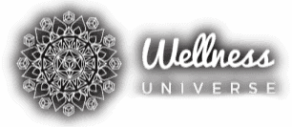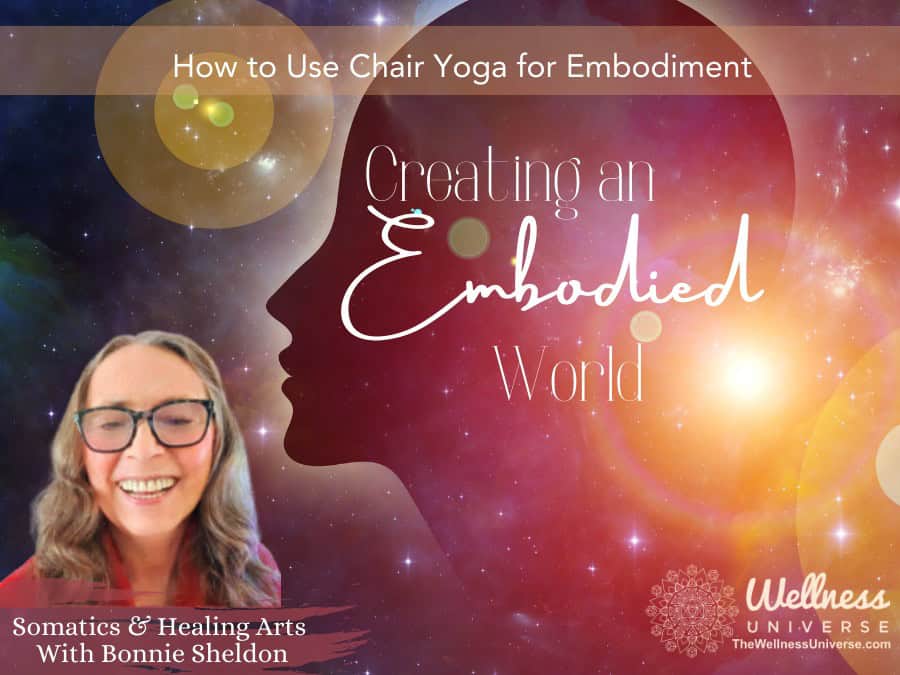In the depths of our unnoticed moments, between stillness and the expanse of the breath, lies the doorway to embodiment.
In our last installment in, we explored how Chair yoga emerges as a beacon of accessibility, inviting us to explore the depths of embodiment from the comfort of our seats. This is not a diluted form of yoga or a substitute; it is a full exploration of embodiment: mindfulness and wholeness of presence, a combination of the sensory felt connection and active-living awareness, which defines embodiment in human beings.
This style of yoga is an invitation to those looking to begin their embodiment practice with ease and fluency. Whether you’re new to the practice or adapting the way you do yoga due to shifting needs of your body, chair yoga stands as a testament to the inclusive spirit of yogic philosophy.
Chair yoga is a bridge between the wisdom of ancient yogic traditions and the needs of our contemporary existence. It offers a path to wellness that respects the body’s limitations and celebrates its capabilities.
As we delve into the ‘how-to’ of chair yoga, we are laying the foundation for a practice that is as nurturing as it is empowering. Together, we will discover the subtle art of tuning into our bodies, embracing the present moment, and unfolding the layers of our being with each mindful breath and movement.
Dispelling Myths About Chair Yoga
Chair yoga typically falls prey to a couple of myths that mischaracterize or could sidetrack or discourage practitioners. We can make these myths clearer with new thinking:
Myth 1: Because I use a chair to keep my balance, chair yoga is easy
Fact: Using a chair is sometimes easier than standing because the chair provides stability. However, most chair yoga poses are still challenging. You’re more than likely to break a sweat with just a few minutes of practicing sun-salutations against a chair back. You utilize your back, abdominal and buttock muscles, as well as your heart and lungs, when standing or sitting in poses.
Myth 2: Chair Yoga Isn’t Challenging
Fact: Adding a chair to a challenging yoga posture greatly increases the effectiveness of a posture, and may reduce the fatigue that can cause boredom or restlessness to set in. But boredom isn’t the answer either. The answer is to find someone who is teaching chair yoga in a way that challenges your body and satisfies your mind. A skilled instructor will help you work hard yet feel relaxed in your poses.
Myth 3: Chair Yoga is Exclusively for the Elderly
Fact: Yoga in a chair is for everyone at any age or mobility. It is for people who like to travel and keep moving. It is yoga for all. It can be for people who have moved past conventional yoga and is ideal for practice in an office setting. Chair Yoga “lunch hours” have become very popular.
Myth 4: Chair Yoga Isn’t Challenging
Fact: Chair yoga challenges are up to the practitioner: using a chair broadly provides a full-body workout that stays close to the ground (with handholds, of course). Modifying it further, either to barely move from the chair or to get a deep and rigorous workout, is a matter of the practitioner’s intention.
Myth 5: Any Chair Fits the Bill for Chair Yoga
Fact: You need the right chair for chair yoga. There are many different types of chairs out there, but you need a sturdy, armless chair for safety and effectiveness. You don’t want to get off your chair at any point, or have the chair move around unexpectedly, so there’s no wiggle room for error.
Myth 6: Chair Yoga Isn’t Authentic Yoga
Fact: Authenticity in yoga derives from the integration of mind, body, and breath. Chair yoga maintains that core element and is therefore authentic yoga.
Myth 7: Chair Yoga Can’t Offer a Full Yoga Experience
Fact: Chair yoga’s benefits are no different than doing yoga any other way: increased flexibility, focus, and stress relief.
If we can consider these myths carefully, we can see chair yoga for what it is: an egalitarian and adaptable practice that can make yoga accessible to more people.
Starting Your Embodied Chair Yoga Practice
While practitioners hold specific postures in chair yoga, or fulfil a supported ‘pose,’ paying attention to how the movements feel and to the breath is more important than the mechanical creation of those shapes. Here are the practice instructions for the exercises, and more details to enhance your understanding of the practice and further options for asanas.
Seated Mountain Pose (Tadasana)
How To
Inhale and move to the edge of your chair, place your feet hip-width apart and don’t let them move during the whole process, flex your sit bones into the chair and lift your spine to sit tall, roll your shoulders back. As you inhale a second time, slowly lift your arms overhead, shoulders down and relaxed, hands shoulder width apart with palms facing each other. Exhale: core gently contracted, spine stacked, feet grounded.
Embodiment Focus
Visualize yourself as a mountain. Solid, strong, majestic. Feel your roots causing your spine to elongate with every breath, your peak reaching toward the clouds.
Chair Cat-Cow Stretch
How to
Put your hands on your knees. Inhale. Push your pelvis back, lift your chest and chin, and pull your shoulders back. You are in the cow position. Exhale. Round your spine, tuck your belly in, and bring your chin to your chest (cat). Do this several times — fluidly from cow to cat and back again.
Embodiment Focus
Feel your vertebrae undulating every time you breathe, in and out, giving you the experience of your breath going up and down the spine with you. Your internal organs are massaged as they lift and descend with the rhythm of your breathing spine. Stuck energies are released. Continue this movement for several breaths, flowing smoothly between cow and cat.
Seated Forward Bend (Paschimottanasana)
How to
Inhale, press your palms overhead. Exhale, fold forward hinging in the hips. Swing your hands as far down as is comfortable, push toward your shins, ankles, or all the way to the floor. Let your head dangle free. No need to crane. Relax your neck. Inhale, get tall, exhale, fold deeper.
Embodiment Focus
In this forward bend, use the opportunity to reflect inside yourself. Notice what you are feeling in your back and in your lower body; notice how your breath expands through your torso. Inhale and extend your arms overhead.
Seated Spinal Twist
How to
Sit tall with your feet on the floor and spine extended. Inhale, extend a little further, then exhale, turn to the right, place your left hand on the outside of the right knee, your right hand on the back of the chair and then look way over your right shoulder. Stay for a few breaths, come back to the center, and repeat on the other side.
Embodiment Focus
With each twist, imagine that you’re wringing the tension out of your body the way you would wring out a wet towel.
Chair Warrior I (Virabhadrasana I)
How to
Sit sideways on the chair with your left foot on the floor and your right leg extended back, toes tucked. Inhale and raise your arms up, hands open towards each other. Exhale and fold, sitting into your left knee, which is over your left ankle. Reach through your right thigh with your left hand and reach through your right hip with your right hand. Feel your open chest and equal breath.
Embodiment Focus
Channel warrior qualities: feeling more powerful in your legs, more open in your chest.
Focus your mind and feel determined in the present moment. Sit sideways on the chair with your left foot on the floor and your right leg extended back, toes tucked. Inhale and lift your arms up, palms facing each other. Exhale and sink into your left knee, ensuring it’s directly over your ankle. Feel the stretch in your right thigh and hip flexor.
Chair Pigeon Pose
How to
Sit in your chair with your feet flat on the floor. Gently lift your right foot and put it over your left thigh, resting it just above your knee. Try your best to keep your right knee in line with your right ankle. Lean forward at the hips and feel your upper body opening as you deepen the stretch with each breath. Hold for several breaths, then switch sides.
Embodiment Focus
As you come into the pose, notice if you are able to open across your right hip. Sit up tall, and lean forward, inviting your sitting bones to ground into the chair and your spine to lengthen from the base of your neck. Breath Awareness: As you take your first breath in the pose, let the tension melt away with every exhale.
Chair Supported Tree Pose
How to
Sit tall in your chair with your feet planted firmly on the ground. Shift your weight slightly onto your left side and place the sole of your right foot on your left inner calf or inner thigh (avoid placing it on the knee). Bring your hands together in front of your heart or raise them overhead like branches. Hold for several breaths, then repeat on the other side.
Embodiment Focus
In this pose, imagine yourself as a sturdy tree. With each breath, feel your roots extending deeper into the ground, providing stability. As you lift your arms, sense the energy reaching upwards, creating space and openness in your chest and heart area.
Addressing Common Difficulties in Chair Yoga
While chair yoga is accessible, some may encounter challenges. Here’s how to navigate them:
Difficulty Balancing: Lean on the back of the chair and also draw weight through the feet
Limited Range of Motion: Move within your comfort zone and use props like cushions or straps to assist.
Breath Awareness: If you lose track of your breath, pause, and take a few deep breaths before continuing.
Mental Distractions: Acknowledge wandering thoughts and gently guide your focus back to your body and breath.
Remember, the essence of embodiment is not perfection but presence. Each movement, each breath, is an opportunity to connect more deeply with yourself.
Modifying postures in chair yoga
Embodiment is about being fully engaged with and responsive to our current physical state and abilities. It’s about honoring our body’s unique needs and meeting ourselves where we are.
When we modify a yoga posture, we are not just making the practice accessible; we are actively listening to our body’s messages. This attentiveness is the essence of embodiment. It’s a dialogue between mind and body, where adjustments are made based on the sensations and feedback we receive from within.
For instance, if you find a standard yoga pose too challenging, modifying it allows you to still engage in the practice without strain or discomfort. This adaptation is not a step back; rather, it’s a step deeper into the practice of embodiment.
By modifying, you are:
Acknowledging your body’s limits and respecting its boundaries.
Cultivating self-awareness by understanding what feels good and what doesn’t.
Practicing self-care by avoiding injury and ensuring the practice is nurturing.
In essence, modifications are not just alterations to a pose; they are affirmations of the principle that yoga, and embodiment, is for everybody. It’s a commitment to a personal journey of mindfulness, where each individual’s experience is valid and celebrated.
Chair Yoga Modifications
Chair yoga is a fantastic way for seniors and people who are beginning their fitness work to maintain flexibility, strength, and balance in a safe and accessible way. Here are some modifications to the chair yoga exercises that cater to the needs of those who are working from the beginning
Seated Mountain Pose (Tadasana)
Modification: For those with shoulder mobility issues, instead of raising the arms overhead, extend them forward at shoulder height or rest them on the lap.
Chair Cat-Cow Stretch
Modification: If full spinal flexion and extension are challenging, focus on moving only the upper back or simply practice deep breathing while visualizing the spine moving.
Seated Forward Bend (Paschimottanasana)
Modification: Place a cushion on the lap to support the chest and head if reaching the shins or floor is difficult.
Seated Spinal Twist
Modification: For a gentler twist, keep both feet on the floor and turn only the upper body, using the chair’s back for support if needed.
Chair Warrior I (Virabhadrasana I)
Modification: If extending the leg back is too strenuous, keep both feet on the floor and focus on the upper body’s lift and opening.
Chair Pigeon Pose
Modification: If crossing the ankle over the thigh is uncomfortable, simply extend the leg out straight and lean forward to stretch the back of the leg.
Chair Supported Tree Pose
Modification: Keep the toes of the right foot on the ground and rest the heel against the ankle of the standing leg for balance.
Navigating Common Difficulties
Stiff Joints: Begin with gentle movements and gradually increase the range of motion as comfort allows.
Balance Concerns: Keep the chair close by for support and perform exercises near a wall if extra stability is needed.
Limited Stamina: Listen to the body’s signals, and take breaks as needed. It’s important to respect your energy levels.
These modifications ensure that chair yoga remains an inclusive practice, allowing everyone to experience the benefits of yoga while honoring their body’s current abilities, growing a sense of the richness and fullness of life.
In our next and last instalment of “Embodiment with Chair Yoga,” we’ll explore “Navigating Embodiment, Overcoming Chair Yoga Obstacles.”
Connect with Bonnie on The Wellness Universe.
All information, content, and material are for informational purposes only and are not intended to serve as a substitute for the consultation, diagnosis, and/or medical treatment of a qualified physician or healthcare provider. The information supplied through or on this page, or by any representative or agent of The Wellness Universe, is for informational purposes only and does not constitute medical, legal, or other professional advice. Health-related information provided through this website is not a substitute for medical advice and should not be used to diagnose or treat health problems or to prescribe any medical devices or other remedies. The Wellness Universe reserves the right to remove, edit, move, or close any content item for any reason, including, but not limited to, comments that are in violation of the laws and regulations formed pursuant to the Federal Food, Drug, and Cosmetic Act. None of the posts and articles on The Wellness Universe page may be reprinted without express written permission.
Peace of Mind Meditations
For the spiritual seeker who wants to relax into a more peaceful mind, body, and spirit. Let go of unneeded thoughts, negative emotions, and worries of the day.
Join us live – https://bit.ly/PeaceOfMindMeditation

see how our self-care books are helping thousands of people around the world. Digital and paperback books are available now.
Connect to the people that help you live your best life: The Wellness Universe

Bonnie Sheldon, an EFT Master Trainer and Somatics expert and guides professionals in achieving stress relief and mindfulness through body-mind integration. Her programs promote self-care, ensuring workplace wellness and success without sacrificing personal well-being or relationships.




